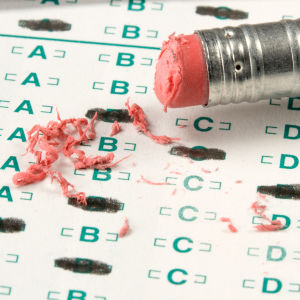National math and reading scores show very little growth and statistically small improvements, according to results released today by the National Center for Education Statistics.
The scores are part of the National Assessment of Education Progress (NAEP), which is referred to as the Nation’s Report Card. Overseen by the National Assessment Governing Board, NAEP provides extensive data and analysis into educational trends and outcomes by comparing scores from fourth and eighth graders every two years on national, state, and district levels. The results this year indicate a growing and disturbing gap between high-performing and low-performing students.
“We know that the nations’ students are making progress, sometimes not as much as we want but we know there is progress,” said Dr. Peggy Carr, associate commissioner of the Assessment Division at the National Center for Educational Statistics.
Michael J. Petrilli, president of the Thomas B. Fordham Institute, was more blunt in his assessment.
“There’s no way to sugarcoat these scores; they are extremely disappointing,” he said.
Nationwide, scores show that fourth and eighth graders made no progress on improving in math. Fourth graders also stagnated in reading while eighth graders had a 1-point increase. Both grades showed marked improvements in each subject from the time when NAEP first published results in the early 1990s. Still, a close look at the data shows that high-performing students tended to increase their scores from 2015 to 2017 while lower-performing students declined.
Individual state scores also showed little to no improvement with the exception of Florida, which showed an increase in scores in both fourth- and eighth-grade math. The school system run by the U.S. Department of Defense, which educates students of military and civilian-connected families around the world, posted increases in each category except fourth-grade reading. All of the scores, however, trended above the national average.
“We are delighted,” said Director Thomas Brady, who functions as the system’s superintendent. “We have some gaps but what we’ve done over the last four years … is the introduction of national standards, college-and-career ready standards, starting in math with elementary school and continuing with reading.”
Proficiency rates, which measure whether students are performing at grade-level expectations, also remain low: 40 percent of fourth graders are considered proficient in math and 35 percent in reading; 33 percent of eighth graders are proficient in math and 35 percent in reading.
“There’s no doubt we’re in a reading plateau,” said Dr. Daniel Willingham, a psychology professor at the University of Virginia who spoke during a panel at the Governing Board’s event at the National Press Club in Washington, DC.
Ian Rowe, chief executive officer of Public Prep in New York City, which works with mostly low-income students, said his organization is not seeing the kind of early literacy foundation that students require to be successful later on in school.
“We spend a lot of time on how to strengthen that foundation,” said Rowe, who was also a speaker at the Press Club. “We are continuously in the process of building a knowledge-based curriculum.”
Although there is a lot of focus on the gaps between white students and those of other races, Rowe cautioned against reading too much into that.
“Poor reading performance crosses racial boundaries,” he said.
Education policy experts and at least one state school chief weighed in on whether the switch to digital tests taken on touch-screen tablets impacted scores. An in-depth analysis from the Thomas B. Fordham Institute raised concerns that that the “the lowest performing and most disadvantaged students saw the biggest declines in their fourth-grade scores, perhaps because these kids struggled with the tablet-based test.” The analysis noted that states that don’t require computer-based assessments were among the worst performers.
Louisiana is one of those states, and the state’s Superintendent of Education sent a letter to Carr last month about this potential inequity.
“[C]oupled with a variety of social indicators that may correspond with low levels of technology access or skill, may mean that computer usage or skill among Louisiana students, or students in any state, is not equivalent to computer skills in the national population,” Superintendent John C. White wrote.
Carr addressed this during the governing board’s event, emphatically saying “No, absolutely not” when asked if declines and flattened scores could be attributed to the switch.
“The trends that you see here today are based upon paper, not digital,” she said.
Jim Cowen, executive director of the Collaborative for Student Success, said the scores are a call to action and cautioned against “lowering the bar” on academic expectations.
“That result serves as a reminder for state policymakers, education officials, community advocates—everyone in the education community—that we must focus more than ever on how to work together to better serve all students and ensure that schools and educators are receiving the supports needed to make necessary improvement,” Cowen wrote in a memo on the Collaborative website.

